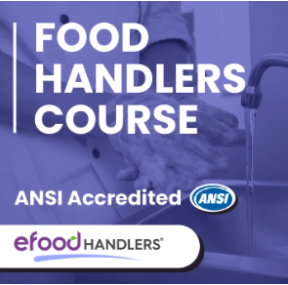The PASS Training Marketplace
Arizona eFoodHandlers - Basic Food Safety Training
Arizona eFoodHandlers - Basic Food Safety Training
Product Description
What is a food handler's card?
A food handler card is a certificate, card, or permit that shows you have completed a food safety course approved by your state and county and understand the basics of food safety.
Do I need an Arizona Food Handler card?
If you handle, prepare, serve, sell, or give away food for human consumption, even if you bus tables or wash dishes, you are a food worker and need this training. Unpaid volunteers are exempt.
When do I need to get my Arizona Food Handler card?
Within 30 days of starting work.
The following counties require you to take a copy of your food handler's certificate and payment to the County Health Department.
Coconino County: Bring your eFoodHandlers Certificate, proof of Arizona state residency, and $20 to the County Health Department at:
2625 N. King Street
Flagstaff, AZ 86004
928-679-8750
or
467 Vista Avenue
Page, AZ 86040
928-608-6108
La Paz County: Bring your eFoodHandlers Certificate, proof of Arizona state residency, and $15 to the County Health Department at
1112 Joshua Avenue #206
Parker, AZ 85344
Monday and Wednesday from 7:00 am until 4:00 pm. The office is closed on Friday.
eFoodHandlers® is a National, ANSI-Accredited Food Safety Training Provider.
Approval
This Arizona Food Handlers Card Training holds the ANAB food handler training program accreditation (ASTM e2659-2015) and is approved for use in Arizona.
Purpose
This program aims to provide food handlers with the information they need to handle food safely. This information may include content specified by state or local regulations.
Scope
This program will teach or reiterate responsible food handling principles to the learner.
This program will teach or reiterate responsible food handling principles to the learner.
Learning Objectives (Effective date April 29, 2020)
By the end of this course, you will be able to:
By the end of this course, you will be able to:
- Recognize how food can cause illness or allergic reactions.
- Prevent contamination of food and food-contact surfaces with the hands and body.
- Identify which symptoms or illnesses must be reported to a manager.
- Use time and temperature control throughout the flow of food.
- Maintain a clean environment for food preparation and service.
- Validity
- 3 years
- Final Exam
- Yes
- Final Exam Passing Score
- 75%
- Certificate
- Yes
- Average Rating
- / 3 Reviews
Foodborne Illness Awareness Chapter 1
Foodborne illness awareness is crucial for preventing food poisoning. Each year in the United States, approximately 48 million cases of foodborne illness occur, leading to 128,000 hospitalizations and 3,000 deaths.
Remember to practice proper food safety by washing hands, separating raw meats, cooking to the right temperature, and promptly chilling perishable foods.
Remember to practice proper food safety by washing hands, separating raw meats, cooking to the right temperature, and promptly chilling perishable foods.
Person-In-Charge Role and Responsibilities Chapter 2
Regarding basic food safety, the person in charge must ensure proper hygiene practices, including handwashing and sanitizing surfaces.
Additionally, they should oversee food storage, handling, and cooking processes to prevent contamination and promote safe consumption.
Additionally, they should oversee food storage, handling, and cooking processes to prevent contamination and promote safe consumption.
Proper Handwashing Chapter 3
Proper hand washing involves thoroughly wetting hands with clean, running water, applying soap, and scrubbing all surfaces (including between fingers and under nails) for at least 20 seconds.
Rinse hands well under running water and dry with a clean towel or air dryer.
Rinse hands well under running water and dry with a clean towel or air dryer.
Health and Hygiene Chapter 4
Health refers to an individual’s physical, mental, and emotional well-being.
Hygiene, on the other hand, involves practices that maintain cleanliness and prevent the spread of disease.
Hygiene, on the other hand, involves practices that maintain cleanliness and prevent the spread of disease.
Cooking Temperatures Chapter 5
When cooking meat or eggs at home, remember these important temperatures:
- Eggs and all ground meats must be cooked to 160°F (71°C).
- Poultry and fowl should reach 165°F (74°C).
- Fresh meat steaks, chops, and roasts are safe at 145°F (63°C).
Use a thermometer to check temperatures and ensure safe food preparation.
Temperature Danger Zone Chapter 6
The temperature danger zone for basic food safety is typically between 40°F (4°C) and 140°F (60°C).
Within this range, bacteria thrive and multiply rapidly, significantly increasing the risk of foodborne illnesses.
Contamination & Cross-Contamination Control Chapter 7
Contamination refers to harmful food substances (such as microorganisms or allergens).
Cross-contamination occurs when these contaminants transfer from one surface or food item to another, potentially compromising safety.


